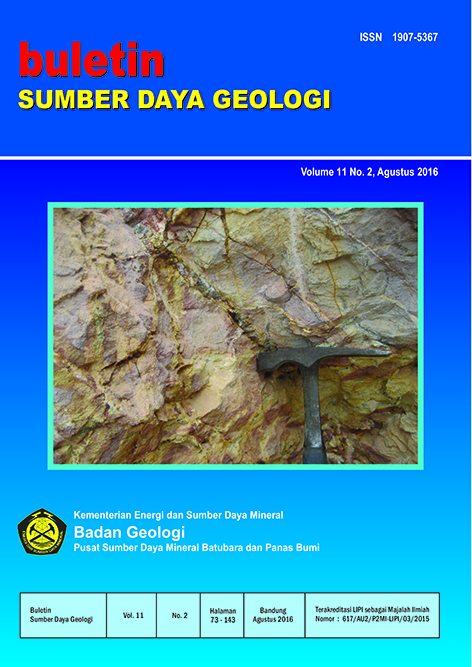ORE MINERALS FROM KUROKO TYPE DEPOSIT OF TOYA-TAKARADA MINE, HOKKAIDO, JAPAN
Abstract
Toya-Takarada mine is Au- and Ag-rich Kuroko-type deposit located in Takarada, Toya-mura, southwest Hokkaido, Japan. The deposits were hosted in rhyolitic tuff and mudstone of Middle Miocene age. Ore samples of fine-grained black ore, vuggy black-yellow ore, granular vuggy black ore, quartz-sulfide ore and massive quartz-barite ore were studied to identify the ore minerals association in the Toya-Takarada mine. The ore minerals are dominated by sphalerite, galena, chalcopyrite and pyrite with fewer amounts of electrum, tetrahedrite-tennantite, and other sulfosalt minerals with secondary mineral of covellite.
The quantitative chemical analysis of ore minerals by EPMA indicated that FeS contents in sphalerite is low (0.3-1.2 mol.%) in all kinds of ore samples. Small grains of electrum as inclusions in pyrite are identified in vuggy black-yellow ore with Ag content around 32-33 atm %.
In general, the silver minerals in Kuroko-type deposits occurred mainly in the black and yellow ores zone dominantly composed of sphalerite, galena, pyrite, chalcopyrite and barite as a form of electrum and/or argentian tetrahedrite-tennantite series. Thus, the massive quartz-barite ore sample of Toya-Takarada mine are also contain some rare silver sulfosalt minerals such as proustite, Cu-rich pearceite, geocronite-jordanite and fizelyite. Those minerals were found together in association with sphalerite. It seems that sphalerite was crystallized first followed by proustite and Cu-rich pearceite, then geocronite-jordanite and fizelyite are crystallized later.
Sphalerites from quartz-sulfide ore of Toya-Takarada contain some fluid inclusions and measured homogenization temperatures are in the range of 164-247°C (av. 208°C) with salinity ranging from 1.9 to 4.7 wt.% NaClequiv. (av. 3.9 wt.% NaClequiv.). The mineral assemblage, iron content in sphalerite and silver content in electrum were indicated that sulfur fugacity was slightly higher during ore mineralization in Toya-Takarada mine.
Downloads
References
Marumo, K., 1985. Geological and mineralogical studies on alteration zones of Lake Toya area, Southwestern Hokkaido. Mining Geologi, 35, 5, p.331-344, in Japanese with English abstract.
Marumo, K. and Sawai, O., 1986. K-Ar ages of some vein-type and Kuroko-type deposits in southwestern Hokkaido, Japan. Mining Geologi, 36, 1, p.21-26, in Japanese with English abstract.
Roedder, E., 1984. Fluid Inclusions. Reviews in Mineralogy, 12, Mineralogical Society of America, Washington D. C, 644p.
Ohmoto, H., 1996. Formation of volcanogenic massive sulfide deposits: The Kuroko perspective. Ore Geology Reviews, 10, p.135-177.
Pisutha-Arnond, V. and Ohmoto, H., 1983. Thermal history, and chemical and isotopic compositions of the ore-forming fluids responsible for the Kuroko massive sulfide deposits in the Hokuroku district of Japan. International Journal of Economic Geology, Monograf, 5, p523-558.
Sato, T., 1977. Kuroko deposits: their geology, geochemistry and origin. Journal of Geological Society, Special Publications, 7, p153-161.
Sawai, O. and Itaya, T., 1993. K-Ar ages of Kuroko-type deposits in the Shakotan-Toya district, Southwest Hokkaido, Japan. International Journal of Resource Geology, 43, 3, p.165-172.
Scott, S. D. and Barnes, H. L., 1971. Sphalerite geothermometry and geobarometry. International Journal of Economic Geology, 66, p653-669.
Shikazono, N. and Shimizu, M., 1988. Electrum: chemical composition, mode of occurrence and depositional environment. University of Museum, University Tokyo Bulletin, 32, 81p.
Urabe, T. and Marumo, K., 1991. A new model for Kuroko-type deposits of Japan, Episodes, 14, 3, p246-251.
Yuningsih, E. T. and Matsueda, H., 2013. Silver sulfosalt minerals from the Toya-Takarada mine, Southwest Hokkaido, Japan. 63rd Annual Meeting of the Society of Resource Geology (abstract vol.), P-04, p.64.
Copyright (c) 2017 Buletin Sumber Daya Geologi

This work is licensed under a Creative Commons Attribution-NonCommercial-ShareAlike 4.0 International License.
Authors whose manuscripts are published agree to the following terms:
The publication rights of all journal manuscript materials published on the Buletin Sumber Daya Geologi website are held by the editorial board with the knowledge of the author (moral rights remain with the manuscript’s author).
The formal legal provisions for access to digital articles in this electronic journal are subject to the terms of the Creative Commons Attribution-ShareAlike (CC BY-SA) license. This means that Buletin Sumber Daya Geologi has the right to store, convert media/formats, manage in the form of a database, maintain, and publish the article without requesting permission from the author, as long as the author’s name is cited as the copyright holder.
Manuscripts published in both print and electronic formats are open access for educational, research, investigative, and library purposes. Beyond these purposes, the editorial board is not responsible for any violations of copyright law.















